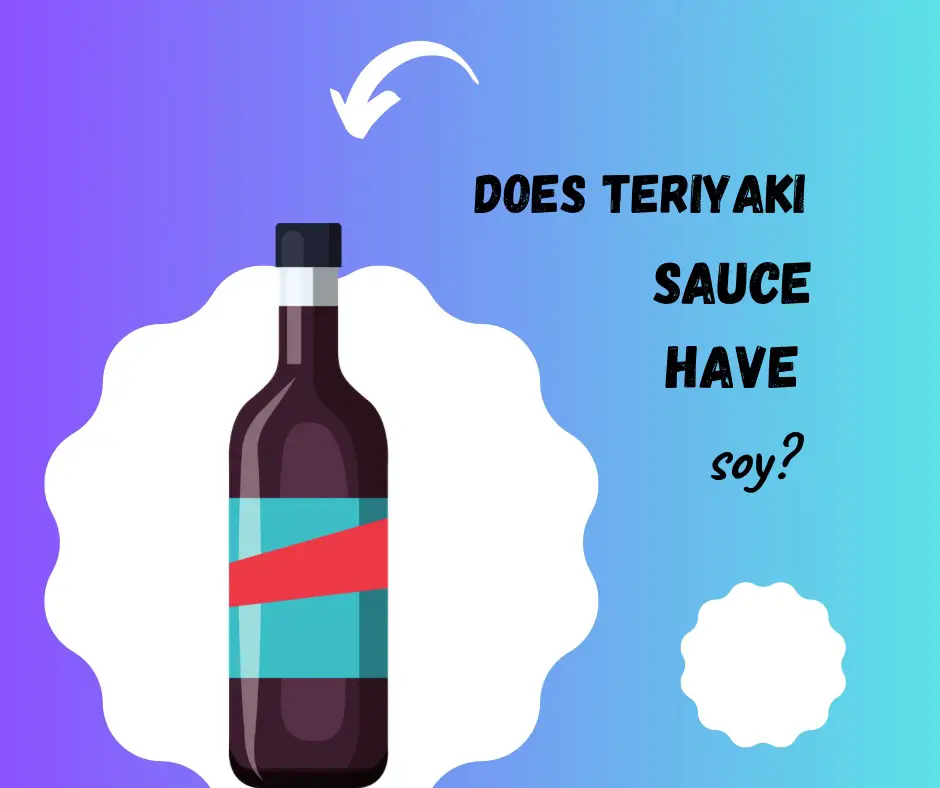Has it ever happened to you? Where you pause mid-bite to ponder the magic behind the very teriyaki sauce you’re using to flavor your salmon dish?
Is soy sauce – and by extension, soybeans – the star player in teriyaki’s irresistible taste? Or are there other ingredients working behind the scenes to create that signature flavor we all know and love?
In this article, you’ll learn exactly what teriyaki sauce is made of and how it is made!

Is There Soy In Teriyaki Sauce?
Teriyaki sauce does feature soy sauce as one of its main components, and because soy sauce is made from cooked soybeans combined with roasted wheat, it’s only natural that teriyaki sauce boasts a generous helping of soy.
If you’re aiming to keep soy off your plate, teriyaki sauce might not be the ideal choice for you.
But don’t be mad as there are countless alternative recipes available online for those seeking a soy-free teriyaki experience.
Just keep in mind that capturing that iconic taste may prove challenging without incorporating traditional ingredients like soy sauce into the mix. Read more about these replacements below.
How Is Teriyaki Sauce Made?
In the most basic state, teriyaki sauce consists of soy sauce (either wheat-based or non-wheat-based for a gluten-free option), rice wine such as sake and mirin and sugar which all come together to create the base of this classic sauce.
If a more complex teriyaki flavor profile is desired, then additional ingredients such as spirit vinegar, salt, spice extracts, onion powder, roasted garlic powder, pineapple essence, honey and toasted sesame seeds are added.
The process of making teriyaki sauce is quite simple yet requires attention to detail.
All ingredients are combined in a saucepan before being brought to a light boil to dissolve the sugar.
The mixture is then allowed to simmer gently while occasionally stirring until it thickens and develops a rich tan-colored foam on top.
Finally, the teriyaki sauce is sterilized and packaged in bottles or containers for distribution.
What Is The Difference Between Soy Sauce And Teriyaki Sauce?
Both teriyaki sauce and soy sauce are cooking sauces, obviously, and therefore serve the primary purpose of enhancing dishes.
Even so, they both play specific roles in cooking albeit, they have many overlapping uses.
Below are some of the ways that teriyaki sauce differs from soy sauce.
Ingredients and Method of Production
Both soy sauce and teriyaki sauce are made from fermented soybeans (with or without toasted wheat), but that mostly where the similarities end.
Soy sauce is traditionally made by fermenting a mixture of soybeans, wheat, salt and water with a specific mold called Aspergillus sojae (and probably many other cultures), for several months depending on the end goal intended to be achieved.
On the other hand, teriyaki sauce is made by combining soy sauce with additional ingredients such as sugar or honey for sweetness, sake or mirin for acidity, and sometimes ginger, spices, seasoning and garlic for added flavor.
Unlike soy sauce that relies on fermentation alone, teriyaki sauce is often simmered until it reaches a thicker consistency.
Taste
While both sauces share a savory umami taste due to their fermented soybean base, there are parts of their flavors that differ.
Soy sauce has a salty flavor with earthy undertones caused by its long fermentation process, whereas teriyaki sauce boasts a sweet yet tangy taste thanks to the addition of sugar or honey and sake or mirin.
Usage
Teriyaki sauce is predominantly used for marinating or glazing proteins like chicken, salmon and other seafood before they’re grilled or pan-fried.
As a glaze, it creates an enticing caramelized exterior while infusing its distinct sweet-savory flavor profile to the dish.
Don’t forget that teriyaki can also serve as a delightful dipping sauce for your favorite sushi rolls or delectable dumplings.
On the other side of the spectrum, soy sauce boasts significantly more versatility in culinary applications.
Much like teriyaki sauce, it’s commonly employed as a marinade. But wait, there’s more!
Soy sauce can gracefully step into various roles such as a condiment, dipping sauce, salad dressing, salt substitute, and even as an essential ingredient in an array of soups, stews and stir-fries.
Can You Make Teriyaki Sauce Without Soy Sauce?
It’s true that when you eliminate soy sauce from teriyaki sauce, you’re venturing away from its traditional roots.
But you have nothing to fear if you’re seeking to avoid soy. There are alternative ingredients available to try and replicate that distinctive taste of teriyaki sauce with soy.
A popular soy sauce substitute is coconut aminos – a gluten-free and soy-free sauce made from the sap of coconut palms. This option delivers a somewhat gentler, yet still delicious sweet-salty flavor that can appease your teriyaki desires.
Other viable alternatives include Maggi seasoning or Worcestershire sauce, which contribute their own unique flavors to the concoction while still offering a manageable depth to your homemade teriyaki sauce.
Can I replace Soy Sauce With Teriyaki Sauce?
While soy sauce and teriyaki sauce share some similarities in their culinary uses, knowing the distinctions between these two condiments is crucial before attempting to swap one for the other in a recipe.
Soy sauce boasts a lighter, less intricate flavor profile compared to teriyaki sauce, which actually incorporates soy sauce as a core ingredient.
If a recipe explicitly calls for teriyaki sauce, it’s best to adhere to this recommendation, as opting for soy sauce instead may yield a lackluster and underwhelming dish in terms of depth and taste.
Conversely, you could feasibly use teriyaki sauce in recipes that require soy sauce; however, be mindful that its sweeter character might influence the final outcome of your culinary creation.
Nonetheless, when using soy sauce as a salt substitute in recipes, it’s not encouraged to replace it with teriyaki sauce.
The sweetness and additional components present in teriyaki could dramatically transform your dish and generate an entirely unintended flavor palette.
Frequently Asked Questions
Does Teriyaki Sauce Have The Following?
Gluten
Indeed, teriyaki sauce often contains gluten, as one of its primary ingredients is soy sauce, which is typically made with wheat, although there are gluten free varieties available for those with dietary restrictions).
Sugar
Yes, teriyaki sauce usually contains sugar to balance the savory and umami flavors. Brown sugar or cane sugar are the common choices to sweeten this popular sauce.
Alcohol
Teriyaki sauce does contain alcohol, but in little amounts. This alcohol comes from the soy sauce (which during fermentation has sugars turned into alcohol) as well as from the use of rice wine or mirin (a Japanese cooking wine).
Honey
While traditional teriyaki sauce recipes don’t typically include honey, it can be used as a substitute for sugar to add sweetness.
Honey-based teriyaki are perfect for use as dips or as glaze before roasting meat or veggies.
Does Teriyaki Sauce Go Bad?
Yes, teriyaki sauce can go bad over time, especially after opening.
It’s essential to refrigerate opened bottles of teriyaki sauce to prevent rapid spoilage since it has lower acidity than other fermented products like soy sauce that naturally inhibit bacterial growth.
For optimal freshness and flavor retention, use your opened bottle of teriyaki sauce within one month after opening.

